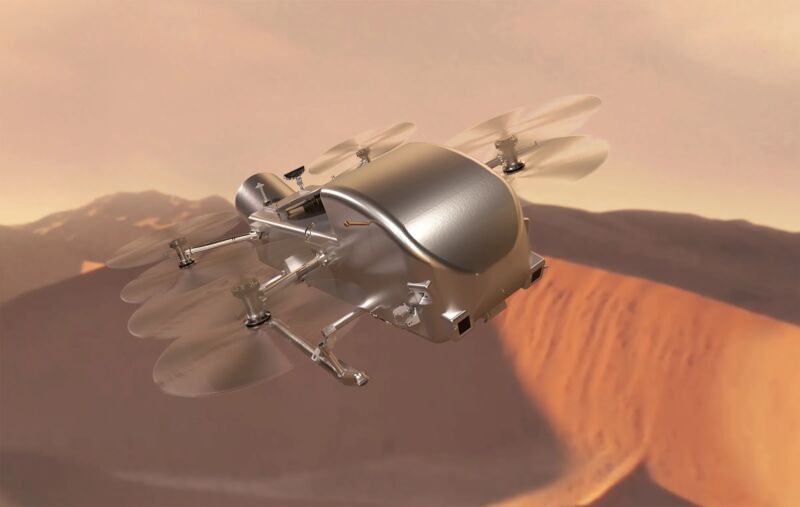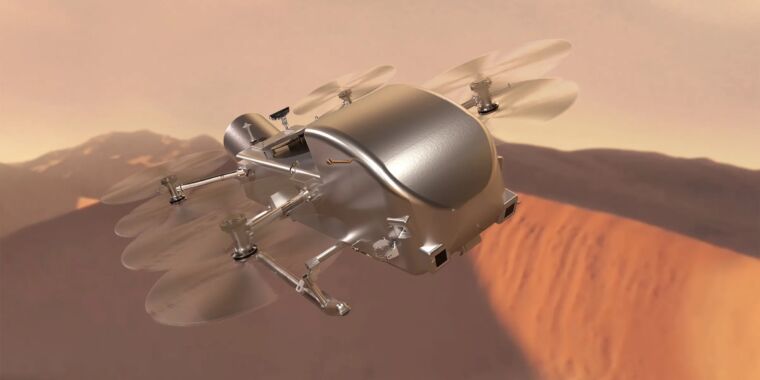
NASA has officially approved the Dragonfly robotic mission for full development, committing to a revolutionary project to explore Saturn's largest moon using a quadcopter drone.
Agency officials announced the results of Dragonfly's confirmation review last week. This review is a checkpoint in the life of most NASA projects and marks the moment the agency formally commits to the final design, construction and launch of the space mission. The outcome of each mission's confirmation review typically determines adherence to budget and schedule.
“Dragonfly is an amazing science mission of broad community interest, and we are excited to take the next steps in this mission,” said Nikki Fox, associate administrator for NASA's Science Mission Directorate. “Exploring Titan will push the limits of what we can do with extraterrestrial helicopters.”
In the case of Dragonfly, NASA has confirmed the mission with a total life cycle cost of $3.35 billion and a launch date of July 2028. This is almost double the original proposed cost of the mission and a delay of more than two years from the date the mission was originally selected. In 2019, according to NASA.
Violation of the cost ceiling
High costs aren't necessarily a surprise on an innovative mission like Dragonfly. After arriving at Titan, the eight-bladed lander will fly from place to place on Saturn's hazy moon, exploring environments rich in organic molecules, the building blocks of life.
Dragonfly will be the first mobile explorer robot to land on any other planetary body besides the Moon and Mars, and the second drone to explore another planet. NASA's Ingenuity helicopter on Mars was the first. Dragonfly will be more than 200 times larger than Ingenuity and will operate six times closer to Earth.
Despite its remote location in the cold outer solar system, Titan appears to be reminiscent of ancient Earth. A blanket of orange haze shrouds Saturn's largest moon, and Titan's surface is covered in sand dunes and methane lakes.
Freezing temperatures on Titan — hovering near minus 290 degrees Fahrenheit (minus 179 degrees Celsius) — mean that water ice behaves like bedrock. NASA's Cassini spacecraft, which flew by Titan several times before ending its mission in 2017, discovered weather systems on the hazy moon. Cassini observations found evidence of hydrocarbon rain and winds that appear to generate waves in methane lakes on Titan.
Titan is clearly a strange world. Most of what scientists know about Titan comes from measurements collected by Cassini and the European Space Agency's Huygens probe, which Cassini launched to land on Titan in 2005. Huygens returned the first images from Titan's surface, but it transmitted data for only 72 minutes.
Dragonfly will explore Titan for about three years, flying dozens of kilometers about once a month to measure the biochemistry of Titan's surface, study its mysterious atmosphere, and search for biosignatures that could be indicators of the presence of life. The mission will visit more than 30 locations within Titan's equatorial region, according to A Presentation by Elizabeth Turtlethe Dragonfly principal investigator at the Johns Hopkins University Applied Physics Laboratory.
“The Dragonfly mission is an amazing opportunity to explore the ocean world in a way we have never done before,” Turtle said in a statement. “The team is committed and excited to accomplish this unprecedented investigation of Earth's complex carbon chemistry. Titan's surface and innovative technology bring this first-of-its-kind space mission to life.”
However, this high level of ambition comes at a high cost. NASA selected Dragonfly to move forward with initial development in 2019. Turtle's science team proposed Dragonfly to NASA through the agency's New Frontiers program, which has developed a series of medium-sized solar system exploration missions. The New Frontiers program has an impressive pedigree, starting with the New Horizons mission that orbited Pluto in 2015, the Juno mission to Jupiter, and the OSIRIS-REx asteroid sample return mission.

“Typical beer advocate. Future teen idol. Unapologetic tv practitioner. Music trailblazer.”







More Stories
Boeing May Not Be Able to Operate Starliner Before Space Station Is Destroyed
How did black holes get so big and so fast? The answer lies in the darkness
UNC student to become youngest woman to cross space on Blue Origin